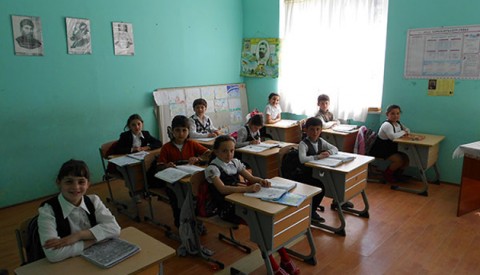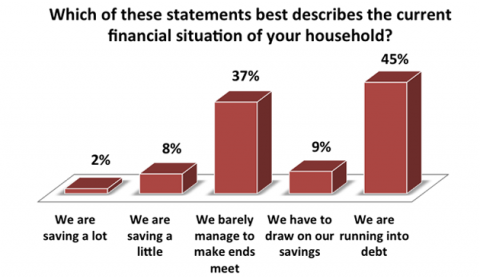As reported in our Khachapuri Index Column, the prices of key khachapuri ingredients have started rising in July, given their strong correlation with the annual cycle of agricultural production in Georgia. A standard portion of Imeretian khachapuri can now be cooked at slightly more than 3GEL, on average. Now, while 3GEL does not sound like a lot for the expats and the better off Georgians, it may be beyond reach for many of the less fortunate Georgian households. To remind ourselves: about 9.2% of Georgia’s population (close to 400,000 people) are classified as “extremely poor” by the Georgian Social Service Agency (SSA). These are people living in households receiving a score below 57,000 points on the poverty measurement scale used by the SSA. One can get a sense of how poor people in this category are by considering the size of the SSA-provided subsistence allowance: 30 GEL per month for single-person families and 24 GEL per every additional family member. Barely enough for a few portions of khachapuri.
The standards applied by the SSA are obviously subject to the usual measurement and classification issues. Yet, the problem of poverty is real, affecting political choices people will be making in October, and – much more significantly for the future of Georgia –the choices and the opportunities available to many thousands of disadvantaged children.
A quick glimpse at the data the ISET Policy Institute collects as part of its Consumer Confidence Index survey suggests that Georgian consumers are anything but confident.
Almost a thousand randomly selected individuals (who own a mobile phone and presumably are not “extremely poor” by the SSA definition) took part in the survey to date. Of these, 45% report running into debt and another 37% barely manage to make ends meet. Only 10% are able to save, and about the same percent is able to draw on savings to survive (hopefully) temporary hardships.
This quantitative result is extremely robust: it appeared in all three rounds of the survey to date (June, July and August); and it is not sensitive to the respondents’ age, gender, education, and whether they live in Tbilisi or any other part of Georgia.
POVERTY: WHO IS TO BLAME AND WHAT TO DO?
Leaving aside the question of “who’s to blame”, we would like to devote the last section of this week’s column to an overview of possible policy responses and how they might play out in the Georgian context.
In principle, poverty alleviation – a major “Millennium Development Goal” – can be pursued in four different ways. One type of response, already discussed above, consists of state-administered charity (“welfare”): modest monetary payments, housing, food or energy subsidies/vouchers, etc. Aiming to provide a minimal level of wellbeing (shelter, calorie intake, etc.), this approach is not particularly effective in treating the root causes of poverty. Moreover, given the meager amounts doled out by the SSA and the fact that many of Georgia’s poor are in fact subsistence farmers, it is not clear whether the current welfare policy is reaching any of its stated objectives.
An alternative approach would be to organize public works and encourage job creation in the private sector so as to absorb some of the long term unemployed (many of whom are poor) into the labor force. In the Georgian context, policies of this type should seek to pull people out subsistence farming – where they have found themselves following the civil war and many years of economic dislocation – into official employment. This is very likely to be an uphill battle: despite all the economic growth achieved in the wake of the Rose Revolution, Georgia was able to add very few new jobs, leaving as much as 50% of its population in agricultural “self employment” (de facto un- or under-employment).
Yet another (complementary) way to promote employment would be to provide the poor and long-term unemployed with the kind of skills that are demanded by the market. This type of “active” and somewhat paternalistic labor market policies are said to be particularly effective in treating the so-called “structural” unemployment – a mismatch between the skills possessed by the unemployed and those required by employers. Not surprisingly, the new Ministry of Employment appears to have been created in July 2012 with the retraining and “retooling” idea in mind. Indeed, according to UNDP’s Human Development Report (2010), Georgia is among the world leaders in providing its younger generation with the wrong kind of (low quality) “higher” education: about 81% of Georgia’s unemployed completed secondary or higher education in 2008. Figures reported by the World Bank are even more dramatic: in 2010, more than 92% of the unemployed in Georgia completed secondary education and more than 40% had a (de facto useless) university degree.
Finally, a poverty alleviation policy should not only treat the current poor, but also prevent the future generations of Georgians from falling into the poverty trap. This is important because poverty can be easily “transmitted” from one generation to another: people trapped in poverty today are less likely to provide their children with the resources and support they need to get a decent education, let alone the capital or connections to start a business.
As far as the future is concerned, it is particularly worrying that, as of 2011, almost 55% of all Georgian children in the 3-5 age bracket were not enrolled in preschools (according to GeoStat data). Many of these children (more than 20%, according to one count) come from extremely poor families, based on the SSA definition. The problem is exacerbated by a lack of uniform policies and procedures given that the public preschool education system is presently under the control of Georgian municipalities. Some municipalities, e.g. Tbilisi, fully cover the cost of preschool education for the poor. Tbilisi’s suburb Rustavi, to take another example, does not provide any coverage, resulting in outright exclusion.
It is our view that in addition to “treating” some of the current poor, for Georgia to win in the war on poverty, there may be no escape from expanding and significantly improving the quality of nationally funded early childhood education systems. While perhaps coming at the cost of expenditures on highly visible, high-risk projects like Lazika, this investment would create great dividends for our children and many generations of Georgian to come.

















Comments